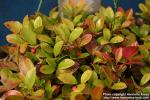Gaultheria.—Wintergreen.

 Related entries: Salix Nigra.—Black Willow
- Salix.—Willow
- Methyl Salicylas (U. S. P.)—Methyl Salicylate
- Betula Lenta.—Black Birch
- Oleum Betulae Volatile (U. S. P.)—Volatile Oil of Betula
- Oleum Gaultheriae (U. S. P.)—Oil of Gaultheria
Related entries: Salix Nigra.—Black Willow
- Salix.—Willow
- Methyl Salicylas (U. S. P.)—Methyl Salicylate
- Betula Lenta.—Black Birch
- Oleum Betulae Volatile (U. S. P.)—Volatile Oil of Betula
- Oleum Gaultheriae (U. S. P.)—Oil of Gaultheria
The leaves of Gaultheria procumbens, Linné (Gaultiera repens, Rafinesque; Gaultheria humilis, Salisbury).
Nat. Ord.—Ericaceae.
COMMON NAMES: Wintergreen, Mountain tea, Deerberry, Teaberry, Boxberry, and improperly as Partridgeberry and Checkerberry.
ILLUSTRATIONS: Bentley and Trimen, Med. Plants, 164; Bigelow, Medical Botany, 22.
Botanical Source.—Gaultheria procumbens is a native, suffruticose plant, with a woody, horizontal root or rhizome, often ¼ of an inch in thickness. The stems are several, ascending about 3 inches from the rhizome, round and downy. The leaves are alternate, evergreen, scattered, near the extremities of the branches, coriaceous, shining, oval or obovate, acute at both ends, revolute at the edge, furnished with a few small serratures, each terminating in a bristle. The flowers are few, drooping, axillary, white, on round, downy stalks. Bracts 2, concave and cordate. The calyx is white, cleft into 5 roundish, acute segments. The corolla is urceolate, 5-angled, contracted at the mouth; the limb divided into 5 short, reflexed segments. Stamens 10, rose colored; filaments white, hairy, bent toward the corolla; anthers oblong, orange colored, ending in 2 double horns, bursting outwardly for their whole length above the filaments; pollen white. The ovary is roundish, depressed, and 5-angled, resting on a reddish, 10-toothed, glandular disk; style erect and straight; stigma simple. The fruit is a small, 5-celled, many-seeded capsule, invested with the calyx, which becomes large, round and fleshy, having the appearance of a bright scarlet berry.—(L.)
History, Description, and Chemical Composition.—This plant is a native of the United States, growing from Maine to Florida, and westward to Pennsylvania and Kentucky, in cool, damp woods, sandy soils, and on mountains, flowering from June to October. It does not grow in alluvial soil, nor in limestone countries. The leaves are medicinal, yet the whole plant may be used; the leaves have a peculiar fragrance and an agreeable, characteristic flavor, with a slight astringency; the berries possess a similar flavor with sweetness, and are eaten by many; some wild animals, as deer, partridges, etc., use it for food. Water, by infusion, and alcohol extract the virtues of the plant. The leaves contain an odorous volatile oil, which may be obtained in the same manner as oil of peppermint. The specific gravity of the oil is 1.173 at 10° C. (50° F.). It is colorless at first, but subsequently becomes more or less of a pinkish color, has a hot and aromatic taste, possesses acid properties, and is soluble in alcohol or ether (see Oleum Gaultheriae).
Mr. J. Oxley, in 1872, found the leaves to contain glucose, chlorophyll, gum, tannic acid, a body analogous to gallic acid, but not yielding pyrogallic acid upon heating, and principles found also in uva ursi and chimaphila, viz.: Arbutin, ericolin and urson. A quantitative proximate analysis of the leaves made by F. W. Droelle (Amer. Jour. Pharm., 1887, p. 289) largely confirmed these results. Volatile oil was found to the extent of ½ per cent. Gaultheria procumbens was ascertained by Prof. Power and N. C. Werbke to be free from andromedotoxin, a neutral poisonous principle present in several plants of the natural order Ericaeae (see Amer. Jour. Pharm., 1889, p. 361).
Action, Medical Uses, and Dosage.—Wintergreen possesses stimulant, aromatic, and astringent properties. It is used in infusion as an astringent in chronic mucous discharges, as a diuretic in dysuria, as an emmenagogue, as a stimulant in cases of debility, and is said to augment the flow from the lactiferous vessels of nursing women, but this is doubtful. It is also recommended as a valuable remedy for articular and muscular rheumatism. The infusion and the essence both relieve irritation of the urethra and bladder, and are adapted to the incipient stages of renal inflammation. Tubal nephritis is alleged to have been arrested by it even when examination has revealed in the urine the presence of blood corpuscles and tube casts (Webster). Scudder recommends it in spermatorrhoea with increased sexual excitement, and as a sedative in irritation and inflammation of the urethra, prostate gland and bladder. The volatile oil (see Oleum Gaultheriae), or its tincture, is used to render syrups and other preparations more agreeable. The oil allays the pain of carious teeth, and large doses of it administered internally have caused death by producing inflammation of the stomach; the essence of wintergreen is a carminative, and is sometimes used in the flatulent colic of infants. An infusion of the leaves or whole plant (℥j to water Oj) may be drunk freely. Dose of essence, 1 to 30 drops; of specific gaultheria, 1 to 20 drops.
Specific Indications and Uses.—Cystic and prostatic irritation, undue sexual excitement, renal inflammation (early stage).
Related Species.—Gaultheria hispidula, or Cancer wintergreen, is supposed to be efficient in removing the carcinomatous taint from the system; used also in scrofula and prolapsus uteri.
Melastoma Ackermanni.—Colombia. Yields an oil probably identical with oil of wintergreen (methyl salicylate). Used provincially as an anti-neuralgic.

